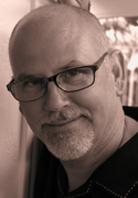Thoughts on Process

J.R. Griffin
1955 Chicago, Illinois
Griffin writes of his work; I have an acute interest in a wide range of imagery. Visual statements heavily rooted in art history as well as images that somehow flow fully developed from my unconscious mind and flash in my imagination. The best of which I try to nurture over time. I don’t sketch so I may consistently work an idea for months in my minds eye. I consider the visual as well as the technical elements needed to execute the work, I review and practice procedures in the same way. Good abstraction is a new visual dialogue with an universal feeling or emotion. Emotion is central to the arts, the success of an idea, is based on the artists ability to incrementally reduce the unimportant aspects in technique until he reaches the glimmering truth.
William Baziotes found he could suggest other worldliness through careful manipulation of surface working them over and over until they shimmered as if bathed in the radiant light of a world where place and time have no boundaries.
Some how, I perceive this wax on, wax off, Zen like devotion to surface, became his studio mantra, occupying his conscious mind allowing his sub-conscious to spill out over the canvas. A long line of beautifully mysterious shapes and relationships, born somehow through a simple diversionary editing system.
Hans Hoffman states ”Every art expression is rooted fundamentally in the personality and the temperament of the artist…. when he is of a more lyrical nature, his work will have a more lyrical and poetic quality. When he is of a more violent nature, his work will express this in a more dramatic sense.”
However, I now believe ultimately it may be our ability to step back, which brings us closer to the deeper intent in our work. Our personality should be withdrawn or sublimated.
Richard Diebenkorn called the spontaneous first impulse a performance “it was to be distrusted for an artist would want to rethink, alter, and discard it.” He went on to say “Making actually meant correcting. Revision was the means not merely of précising pictorial thought, but of thinking itself.”
So, in a broader sense this repetition, reduction, revisionist editing becomes the struggle, which brings fitness or renewed vigor to one’s visual statement.
This self-aware struggle of discovery is the motivation for a lifetime of production.
William Baziotes “A commemorative Exhibition”
Freedman Gallery, Albright College , Reading, PA
Hofmann, Cynthia Goodman, Abbeville Modern Masters
Richard Diebenkorn “The Art of Richard Diebenkorn”,
Jane Livingston, Whitney Museum of American Art
|